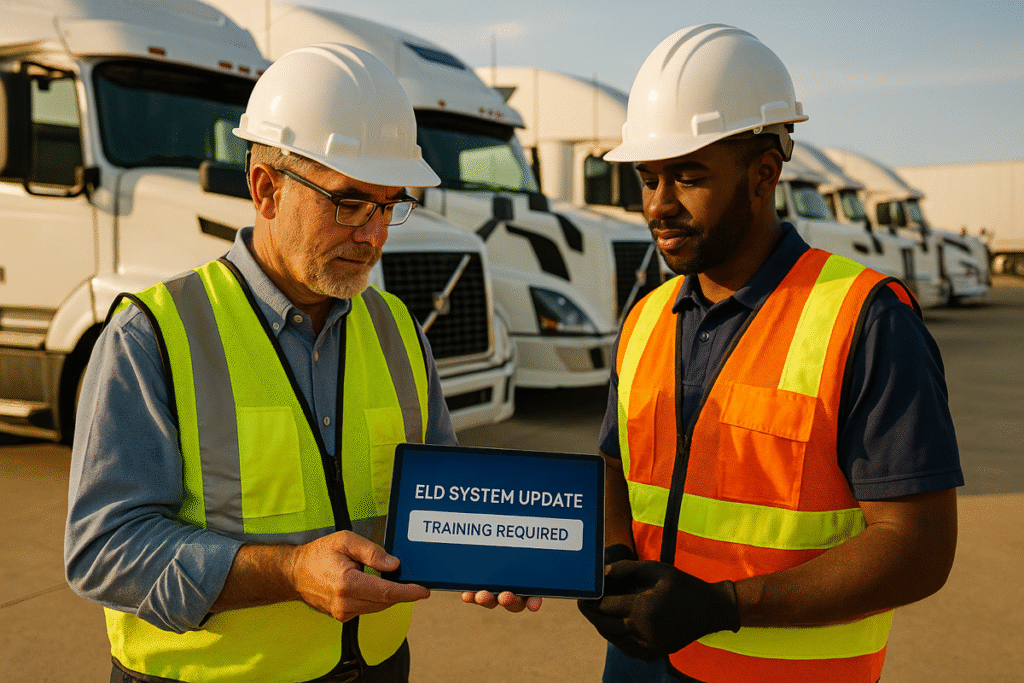
Gaps in Training for New ELD System Updates

Electronic Logging Devices (ELDs) are central to Hours-of-Service (HOS) compliance, but each firmware or software change can introduce confusion when driver and dispatcher training does not keep pace. The result is avoidable violations, inaccurate records, and lost trust in the system. FMCSA’s ELD program explains the rule’s purpose and scope, including how ELDs synchronize with the engine to ensure accurate RODS and HOS data capabilities that shift as devices are updated (Federal Motor Carrier Safety Administration, 2023). FMCSA’s general information and FAQs further detail portable device mounting, data transfer, and required features that are commonly affected by updates (FMCSA, 2018; FMCSA, 2022a).
Training gaps often surface around malfunctions and data-diagnostic events. FMCSA provides specific guidance on what the device must monitor, how carriers should respond, and when drivers must revert to paper RODS until the unit is restored procedures that must be re-taught whenever device logic or menus change (FMCSA, 2018; FMCSA, 2022b). Because providers self-certify and updates vary, carriers should also track device status against FMCSA’s official ELD site and FAQ hub to anticipate changes that affect training content (FMCSA, n.d.-a; FMCSA, n.d.-b).
Human-machine interaction matters as much as the regulation. NHTSA’s human-factors guidance for driver-vehicle interfaces underscores that interface clarity, predictable alerts, and minimized cognitive load reduce error principles that apply directly to ELD screens, prompts, and workflows after updates (National Highway Traffic Safety Administration, 2016).
For construction firms with DOT-regulated fleets, transportation carriers, general industry shippers, and environmental contractors moving regulated materials, retraining must be built into change management. Map each ELD release to quick refresher drills, update task aids for data transfer and annotation steps, and require supervised log reviews for the first week post-update. Aligning practices with the four safety pillars strengthens outcomes: safety & health training through micro-modules on new fields and screens; hazard prevention & control through clear malfunction protocols; worksite analysis via weekly ELD error trend reviews; and management commitment & employee involvement through coaching ride-alongs and recognition for clean audits.
At Key Safety LLC, we operationalize this with Document Development for Start-up Projects that codify ELD SOPs, quick-reference cards, and change logs; Service on Demand for rollout huddles, ride-along coaching, and post-update audits; and Regular Consultation Service to monitor FMCSA updates, analyze error patterns, and sustain compliance.
References
Federal Motor Carrier Safety Administration. (2018, April 9). ELD malfunctions and data diagnostic events. U.S. Department of Transportation. https://www.fmcsa.dot.gov/hours-service/elds/eld-malfunctions-and-data-diagnostic-events
Federal Motor Carrier Safety Administration. (2018, April 9). General information about the ELD rule. U.S. Department of Transportation. https://www.fmcsa.dot.gov/hours-service/elds/general-information-about-eld-rule
Federal Motor Carrier Safety Administration. (2022a, March 10). ELD technical specifications FAQs. U.S. Department of Transportation. https://www.fmcsa.dot.gov/hours-service/elds/eld-technical-specifications-faqs
Federal Motor Carrier Safety Administration. (2022b). ELD malfunctions and data diagnostic events—FAQ topic. U.S. Department of Transportation. https://eld.fmcsa.dot.gov/FAQ/Topics?name=ELD_Malfunctions_and_Data_Diagnostic_Events
Federal Motor Carrier Safety Administration. (2023, October 2). Electronic logging devices (ELDs). U.S. Department of Transportation. https://www.fmcsa.dot.gov/hours-service/elds/electronic-logging-devices
Federal Motor Carrier Safety Administration. (n.d.-a). ELD—FAQs. U.S. Department of Transportation. https://eld.fmcsa.dot.gov/faq
Federal Motor Carrier Safety Administration. (n.d.-b). ELD home page. U.S. Department of Transportation. https://eld.fmcsa.dot.gov/
National Highway Traffic Safety Administration. (2016, December). Human factors design guidance for driver–vehicle interfaces (Report No. DOT HS 812 360). U.S. Department of Transportation. https://www.nhtsa.gov/sites/nhtsa.gov/files/documents/812360_humanfactorsdesignguidance.pdf
Comments:

